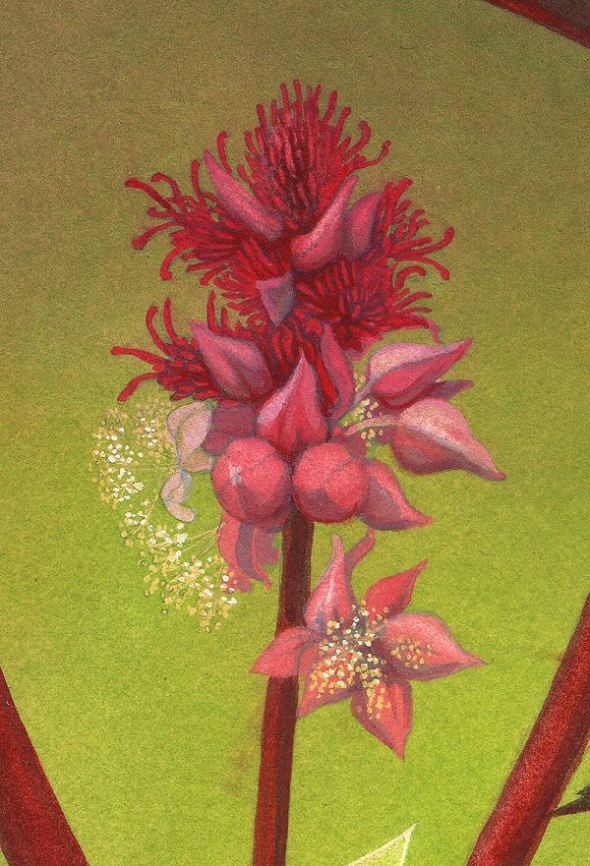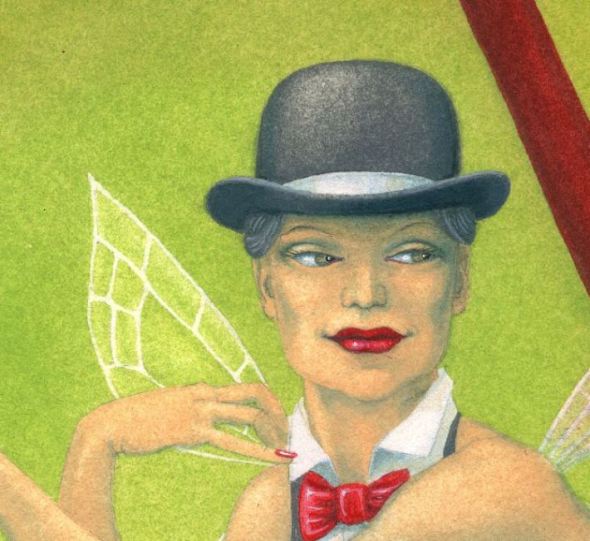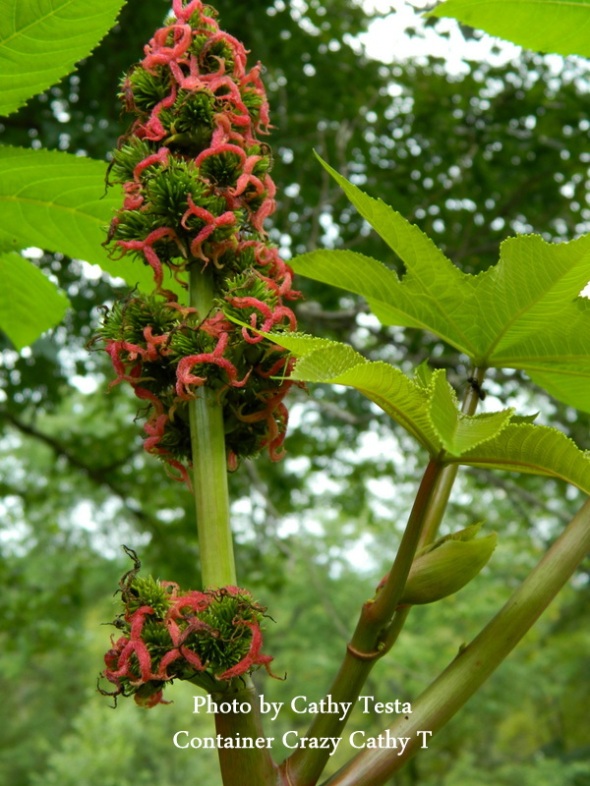Perhaps the only person to definitely know if the castor bean plant and its three little seeds lying within each of its seed capsules has been and continues to be falsely portrayed as a lurking killer is the beautiful and bold imaginary fairy by the name of Ricina, a clever creation by Nancy Farmer, an artist residing in the United Kingdom.
A FAIRY
- “a small imaginary being of human form that has magical powers, esp. a female one.” (source: Google)
Art may be left up to the interpretation of the admirer or defined by its originator but my perception of Nancy Farmer’s creation, the fairy she named Ricina, is of a mature woman seductively perched upon the stalk of a castor bean plant. With her eyes glanced to the side and a sneaky facial expression, Ricina appears to be ready to protect or serve the possible magical yet deceptive powers of the plant and its seeds. Her bright red lips and finger nail polish flanked by a smart little red bow tie around her neck matching her classic attire provides the admirer a glimpse of her individualistic style. And she looks a little playful too with a suggestive rise in her sexy leg and fashionable but just the right sized heeled shoes. A handsome umbrella dangles from the tips of her fingers and she sports a masculine hat – teasing mementos to remind of past stories and tales regarding the castor bean seeds and its potentially lethal toxin known as ricin.
If Ricina could buzz by our ears, perhaps she would whisper there is nothing to fear. For only those with harmful and deliberate intentions could possibly use the plant’s powerful little bean-shaped seeds for malice and not joy. She knows it requires the elements of keen knowledge about the plant’s toxic components and a bit of unrealistic determination by the offender. Or maybe she would tell us only a fool would pry apart prickly seed capsules designed to keep predators at bay and then chew its seeds obviously marked with suspicious patterns.

Nancy Farmers artwork of the castor bean flowers (www.nancyfarmer.net and anancyfarmer.wordpress.com)
She would continue to reveal the beautiful benefits of the plants’ ornamental characteristics and its ability to thrive with little encouragement to provide grandeur in our gardens. As she continues to deflect our attention from unproven matters of the castor bean plant, she may fly around exclaiming the exceptional as well as unattractive features of the plant from its large showy leaves, a towering height, and flowers with a combination of features as complex as its tales. The key, she should would say, is to admire ‘all of the plant’s’ wonderful virtues along with its adversity. Because the castor bean plant has its good and bad sides.

Source Permitted by: Nancy Farmer of http://www.nancyfarmer.net and nancyfarmer.wordpress.com
THE CASTOR BEAN PLANT
- “A large shrub of tropical Africa and Asia having large palmate leaves and spiny capsules containing seeds that are the source of castor oil and ricin; widely naturalized throughout the tropics.” (source: thefreedictionary.com)
The castor bean plant or castor oil plant (Ricinus communis) is a tropical shrub or tree hardy in planting zones 10-11. It is treated as an annual in Connecticut’s planting zones since it will not survive winter temperatures here. The plant grows rapidly from seed when planted in ideal conditions. It can easily reach between ten to twelve feet in a single season. As the stalk increases in diameter, it resembles thick bamboo. Large distinctive green leaves growing from the tips of long petioles are lobed shaped with several pointed star-like tips. The species is primarily green, but cultivars come in vivid red to maroon colors, including the seed capsules.
The plant’s odd-looking flowers consist of separate male and female flowers on the same plant. When both sexes are on the same plant, this is termed monoecious. The male flowers are white and tiny, situated just below the female flowers. Red styles, the narrow part of the pistils, are clearly visible on the female parts of the plant.
Round seed capsules grow from the female flowers which are rather interesting. They are composed of three joined lobes or hulls covered with soft prickly spines. Inside each prickly capsule are the infamous castor bean seeds, known to be the source of a potentially lethal toxic, known as ricin. Although the castor bean seeds are the size of edible beans, think kidney beans – they are not true beans at all. And they are not meant for direct consumption, but used for the production of castor oil and other traditional medicines. Some people think the seeds resemble inflated ticks, and the genus name Ricinus is the Latin word for tick.
A POISON
- “a substance that, when introduced into or absorbed by a living organism, causes death or injury, esp. one that kills by rapid action even in a small quantity.” (source: Google)
- “a person, idea, action, or situation that is considered to have a destructive or corrupting effect or influence.” (source: Google)
Relief from the use of castor oil derived from the seeds of the castor bean plant (Ricinus communis) may yield some benefits for people still using this remedy as a laxative, but there are reported sinister sides to the seeds, that when used in a specific fashion and with its toxic substance, will lead to illness and sometimes death of an unsuspecting victim. Some stories or myths shared from past to present about such occurrences, including claims of sneaky murders from administering ricin with a common umbrella as the mode of transmission, to claims of accidental deaths from chewing the seeds without the realization of the disastrous results days later, may be somewhat exaggerated.
In the words of John Robertson who has spent ten years researching, writing and talking about poisonous plants:
“But, though ricin is extremely poisonous it actually does little harm. Around one million tons of castor beans are processed each year for castor oil production leaving the waste pulp with up to 50,000 tons of ricin in it. And, yet, finding instances of ricin poisoning is not an easy task.“ (source: THE POISON GARDEN website)
Victims are said to suffer from vomiting, diarrhea and dehydration once attacked by the evil person in possession of the ricin. Others have eaten the castor bean seeds in ignorance with the belief it is a medical solution to their health problem. Yet the more you read regarding the poisoning powers of the infamous castor bean seeds, the more unclear the accusations and exaggerations become regarding the potential for eventual death to occur. Some sources attempt to explain the differences between poisonous and dangerous because a person can do no harm without the right combination of both a lethal toxin and attitude.
In a ten minute video on THE POISON GARDEN website about ricin, John Robertson states, “There’s a big difference between poisonous and harmful. For a poisonous plant to become harmful, there has to be a way to administer the poison.“
THE HAPPY TOGETHER
Many references will indicate you should keep the castor bean plant and especially its seeds away from children or animals, and should you have either, this may be a needed precaution. More important, I would say, is to be knowledgeable about the plants before placing one in your gardens. Unlike plant tags listing all the beneficial reasons a plant is successful (a winner, deer-resistant, hummingbird magnet, drought tolerant, etc.), the downsides of plants are not indicated at all. One is to wonder if plants should have warning tags (e.g., potentially toxic, invasive, aggressive, addictive, etc.) but for obvious reason, they do not. However, I have grown castor bean plants at my home and so have many others worldwide. In some parts of the country, the plant grows as a common roadside weed and the population of people near these situations are aware of its hazards. Similar to other things in our society which are dangerous under the wrong circumstances and in the wrong hands, we must just be more educated and not be put in a state of fear. After all, if the castor bean plant and its potential poison is a killer, why am I not dead?
Racina, the plant, and myself co-exist without any ill effects – and you can too if you admire the castor bean plant’s features. One way to limit your anxiousness regarding the prickly seed capsules with seeds within is to remove the flowers all together on the plant, or remove the capsules before they mature and potentially crack open to drop seeds on the ground. Wild animals seem to understand the precautions and warnings provided by the plants as an adaptation to say “don’t eat me, stay away, I’m trying to reproduce. And if you tempt it, I will make you sick enough so you remember.” How incredibly wondrous by the plant. Racina, as I imagine her, understands this. She, the plant, and the poison all live happily together.
And I think you could too,
Written by Cathy Testa©
P.S. A very special thank you to Nancy Farmer, the obviously talented artist capturing the essence of the castor bean plant’s legends with a fairy. She and her amazing works of combining ‘nature with art’ may be found at:
http://nancyfarmer.wordpress.com/
References and Other Sources:
http://www.uicnmed.org/nabp/database/HTM/PDF/p86.pdf
http://en.wikipedia.org/wiki/Castor_oil_plant
http://www.thepoisongarden.co.uk/atoz/ricinus_communis.htm
http://www.missouribotanicalgarden.org/PlantFinder/PlantFinderDetails.aspx?kempercode=b459













Great and informative read ! Thanks ! And as I was looking at the seeds – I too (before I got to your words)…. thought “OMG – they look just like huge ticks” – Eeeewwwwhhhh !!!
Dianne, Remember when you saw the plant here? – and I mentioned the toxicity. Your reaction was priceless – saying, You can keep this plant here! I know you are an avid animal lover so I “totally” understand, as a friend of mine did have a sick dog from eating a plant in her yard once (not this plant – but another one), and she is into horticulture (she felt terrible!), but thankfully her dog survived. Cath
I am just now reading this….. LOL – Glad that you know what a “freak” I am about animals – but I also soooo know that you are extremely well versed and knowledgeable on all that grows. That’s why you don’t worry. Me on the other hand – when the “kids” are on my watch…. I am a staff Sargent and have to protect. 🙂 But I do have to say – when I did first see these “tiny” plants and now what they look like – SO COOL !!
Dianne, Freak is not the word I would use – you love animals and that is VERY cool, so that’s a GOOD FREAK!! 🙂 Cath
P.S. – I think this particular fairy “Ricina” would make a cool tattoo !!! (just my opinion). She’s cool !
Lovely article, Cathy, have posted it to my facebook page. By the way, I have grown this plant (though not this year as nobody gave me one, and round here, it ialso does not survive the winter…), plus Foxgloves, Monkshood, Rhubarb, Nicotiana, Aquilegia, and a probably others famous for being toxic. I have cats: they are sensible enough not to eat them, also chickens what are not sensible but still seem to be alive and well. Sometimes people can get paranoid and it is better to teach people about nature than to ban it for safety reasons!
Oh and yes, the seeds do look disturbingly like tics, now you mention it… having removed one from a cat last week… ewwww! 😉
Nancy, I’m especially glad to hear about the chickens, as I had them twice on my property but live predators like fox and hawks got my chickens. I so love your art work very, very much. Thank you for sharing your stories in such as way no words are required. Cathy T
Pingback: The Mystery of the Missing Sea Pumpkin | Container Crazy Cathy T
Pingback: The Container Garden Take Down Process Begins | Container Crazy Cathy T
Pingback: Ways to Decorate Containers for Autumn and Halloween | Container Crazy Cathy T
Pingback: Repurposing Perscription Pill Bottles as Seed Containers | Container Crazy Cathy T
Pingback: Autumn Brings Beauty and Overwintering Work for Gardeners | Container Crazy Cathy T
I was completely drawn to these plants and my mother told me my grandmother loved them. Maybe it’s genetic but they are just beautiful! I live in Kentucky so they will not make it through the winter but I planted five in my yard. The one that is the tallest, about 4 feet, is snapping at the base when a storm comes through. Last time I put a support wire (wire around the actual plant has a rubber cover) but last night’s rain toppled it over, again, the direction towards the support anchor. It is probably a third of the way severed at the base, and I’m wondering if there’s any hope for it. Not sure why this is happening but think I should probably support the other four smaller ones. Any suggestions or know why this is happening? The width of the plant is probably 3ft and the ‘trunk’ is maybe 2″ in diameter.
Hi, Thanks for visiting my blog and asking about Castor Beans. I don’t understand, however, why your plants topple over. Usually their stalks become quite strong, so I suspect it could be something in the soil, or timing of when you planted it? Not sure. I find if I want to plant my starter plants (which I grow from seed), and plant too late, they don’t thrive. Or maybe it is the depth of your plant when you plant it – too high perhaps, but I’m not sure. When I grow castor beans, they get quite huge and never have toppled. Sorry I can’t be of more help! Cathy T.
Pingback: Photos of Me, Cathy T | Container Crazy CT
Pingback: Five Random Plant Photos and The Story Behind Them | Container Crazy CT